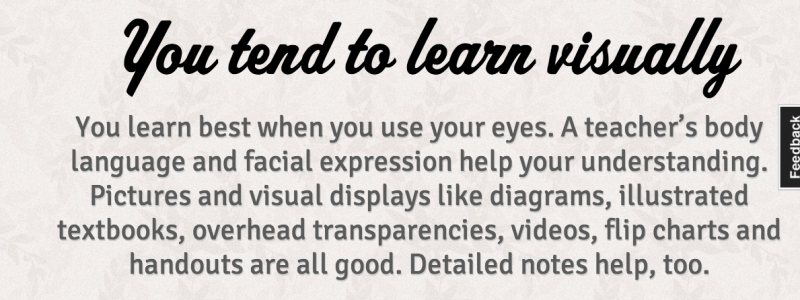Serendip is an independent site partnering with faculty at multiple colleges and universities around the world. Happy exploring!
et502's blog

Thoughts on my last day at my placement and "productivity"
My last day at my placement was surprisingly calm. The students had a short day at school, so they'd had a full 3 hours to relax before coming to Wordsmiths. What a difference that made in attitude and atmosphere! We were so much more effective; everyone was in a good mindset for working. I think that, by itself, was really telling of what students need in their daily routine: time to relax.
The student that I worked with, Bianca, said that she spent all 3 hours on her kindle, playing games. And when I think about it, I sometimes need a few hours to unwind--and I end up watching videos on Hulu or talking with friends. And that time is not "wasted"--though it's hard for me to think about it as useful, since so often, we talk about relaxation time as "unproductive."
In fact, I think those hours of "non-productivity" contribute to a sense of balance and, with reflection, internally-driven motivation to get things done when you do sit down to work. You need to hibernate, in order to create. It's unfair to expect students to produce constantly. I, personally, prefer intense work interspersed with calm/relaxation/physical activity. Longer days, working without pausing to relax, seem somehow less productive and more like busy work. I sense that some of the students at my placement feel the same way.

Who's in charge? (situation is unclear)
Yesterday, the site supervisor was not at Wordsmiths. She had another commitment this entire week, so she’d emailed me and several other interns beforehand to let us know. In the email, Mariah had said that we should use the time-out discipline structure as needed, and had told us to call her if anything went awry. Since I knew she’d given keys to other people, I assumed she had just included me on this list so that I’d be prepared for the situation.
 When I arrived on Wednesday afternoon, there were 2 other interns there. They told me that they had been there on Monday and Tuesday as well. I suggested that we go outside first, since it was nice out; I remember thinking that, when I was there 2 weeks ago, it might have been night to get some of the kids’ energy out before making them sit down and do work. Both interns disagreed with me—they said that the kids had “gotten better” in the past weeks, and they wanted to stick to this routine.
When I arrived on Wednesday afternoon, there were 2 other interns there. They told me that they had been there on Monday and Tuesday as well. I suggested that we go outside first, since it was nice out; I remember thinking that, when I was there 2 weeks ago, it might have been night to get some of the kids’ energy out before making them sit down and do work. Both interns disagreed with me—they said that the kids had “gotten better” in the past weeks, and they wanted to stick to this routine.
In this situation, I felt that I was more like a “volunteer” than an “intern”—I definitely did not feel that I had the authority to make decisions that would affect the schedule. I wanted to, but deferred to the interns’ decision. However, I think that these other two girls were also unsure of their authority; they didn’t want to deviate from the normal programming, even if it could be a positive experiment.

How do you learn?
A few years ago, I signed up to get email updates from Sophia.org, a site that compiles online tutorials and resources for both students and teachers. Today's email: Do you know your learning style? Find out using SOPHIA's learning preference assessment. Take our two-minute adventure and you'll be on your way to making the most of your learning potential.
So of course, I took it. While I think my learning style is slightly more nuanced than their response, it was fun to reflect on the kind of teaching that I respond to..


What will schools be like in 100 years?
Hi everyone!
 I was thinking about the school-drawing prompts from both our group (Just Dewey It) and the group presenting about creativity (CHES)... So this event caught my attention.
I was thinking about the school-drawing prompts from both our group (Just Dewey It) and the group presenting about creativity (CHES)... So this event caught my attention.
I've been following Lynda Barry, an artist/cartoonist/all around awesome person, on Tumblr. She recently hosted a workshop doing something similar to our prompt - but involving kids in the process of imagining. Here are some photos from that event: http://thenearsightedmonkey.tumblr.com/post/47543409124/some-photos-from-the-counter-factual-campus
and here's the poster for the event: http://wid.wisc.edu/content/uploads/2013/03/Drawing-Jam.pdf
Intersections between art, imagination, and planning.. wish I could have gone to this!

Teacher’s resignation letter: ‘My profession … no longer exists’
 I know we've been trying to keep the discussion postitive, but I found Gerald J. Conti's letter of resignation to be particularly moving.
I know we've been trying to keep the discussion postitive, but I found Gerald J. Conti's letter of resignation to be particularly moving.
Conti writes about a number of things that we have touched on in class conversations:
- systematic mistrust of teachers
- generic assessments as a detriment to creativity and critical thinking
- lack of leadership
- privatization of school programming
He writes, "STEM rules the day and “data driven” education seeks only conformity, standardization, testing and a zombie-like adherence to the shallow and generic Common Core, along with a lockstep of oversimplified so-called Essential Learnings. Creativity, academic freedom, teacher autonomy, experimentation and innovation are being stifled in a misguided effort to fix what is not broken in our system of public education and particularly not at Westhill."

Situations of Structure - for 4/11
 Hey Everyone! Emily, Riley, Elizabeth, & Nicole here! Please respond to this post - We're going to use your Serendip repsonses for a silent discussion/reflection activity.
Hey Everyone! Emily, Riley, Elizabeth, & Nicole here! Please respond to this post - We're going to use your Serendip repsonses for a silent discussion/reflection activity.
Think about a situation in your placement where you saw structure (or lack of structure). Was it conducive to learning? Write 1-2 paragraphs about this moment.

Timing and distractions
On Tuesday, I worked with Erica again on both reading and homework. “Work with me, work with me,” she asked, so I agreed to come upstairs and work with her. After 20 minutes of reading, we switched to work on homework.
Looking back over my notes, I was surprised by the number of distractions we had. While we were reading, a tutor and a student came upstairs and started reading out loud too; another student had a tantrum in the corner and the director, Mariah, and 2 other tutors were talking to him for 5-10 minutes to get him to settle down. Erica was, for the most part, able to stay focused during that time. However, when we were doing homework, she was more prone to distraction – both of her own making, and others.
Erica had one double-sided worksheet of math problems. She wanted to work upstairs instead of downstairs, where students usually do homework – I assumed this was because it was a little quieter and less hectic upstairs. We sat down on a couch, and Erica took out two whiteboards, and put her paper on top of them. She also got a sharpened pencil and a dry-erase marker.

peach rings
I'm confused about how discipline/management of student energy should be happening at my placement. A few weeks ago, Mariah, the programming director, briefly told us that Wordsmiths uses a point system. Today, she handed out printouts to each of the kids when they came in - Erica got 75% positive points yesterday, so the circle showed up 75% green. Another student only had 42% positive points.
However, to my knowledge, none of the tutors have learned about this system or how to implement it. I didn't even know some of the rules until today (kids aren't allowed to go upstairs without an adult, students have to ask for permission to go outside, we don't use the "shut up" phrase, we don't use cuss words, no food from outside of Wordsmiths - especially candy).
 So I was outside with some of the kids for recess and I saw Bianca was talking with a friend. A few minutes later, I noticed that she was chewing something. Typically, the students are not supposed to have snacks of any kind until after recess when they go back inside (Wordsmiths provides fruit and yogurt). I asked her what she was eating. She said, "Nothing!" and backed away from me. She put one hand behind her back. Erica told her she better finish it quick.
So I was outside with some of the kids for recess and I saw Bianca was talking with a friend. A few minutes later, I noticed that she was chewing something. Typically, the students are not supposed to have snacks of any kind until after recess when they go back inside (Wordsmiths provides fruit and yogurt). I asked her what she was eating. She said, "Nothing!" and backed away from me. She put one hand behind her back. Erica told her she better finish it quick.

Guided reflection - math strategies
1. and 2.: Collect stories/What happened? – Miranda helped Omar do his math homework
Once again, we had more volunteers than students at tutoring. Mariah – the director of Wordsmiths – asked Miranda and I to work with Omar. He had not been in school that day, so he needed to do both his schoolwork and some homework, which had been compiled into a packet. Since Miranda had worked with him before, I let her lead; so, for the most part, I just watched. Omar said he already knew how to do this, and that they didn’t need to work on it today. Miranda said that he needed to finish as much as possible, since there wouldn’t be tutoring tomorrow or the next day. She repeated that he had to do it today.
Omar started with the first page, which was 3 columns of basic addition (ex: 1 +2 = ?; 3 +7 = ?). For the first few questions on the first column, Omar used one of two strategies: he wrote tally marks for each number and counted up the total (ex: I II = 3; III IIIIIII = 7), or he used his fingers and counted from left to right (ex: 1 finger on one hand next to 2 fingers on the other hand). When the numbers were too big to fit on one hand (ex: 7), he used tallies. Miranda and I both watched him. For some of the equations that Omar was going to use fingers for, Miranda held up her own fingers and told Omar to look up. He counted her fingers and used that number. He said the answer out loud before writing it; when the answer was wrong, Miranda asked, “Are you sure?” or said, “Check that again.”


